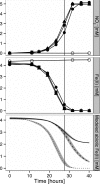Ligand-enhanced abiotic iron oxidation and the effects of chemical versus biological iron cycling in anoxic environments
- PMID: 23402562
- PMCID: PMC3604861
- DOI: 10.1021/es3049459
Ligand-enhanced abiotic iron oxidation and the effects of chemical versus biological iron cycling in anoxic environments
Abstract
This study introduces a newly isolated, genetically tractable bacterium ( Pseudogulbenkiania sp. strain MAI-1) and explores the extent to which its nitrate-dependent iron-oxidation activity is directly biologically catalyzed. Specifically, we focused on the role of iron chelating ligands in promoting chemical oxidation of Fe(II) by nitrite under anoxic conditions. Strong organic ligands such as nitrilotriacetate and citrate can substantially enhance chemical oxidation of Fe(II) by nitrite at circumneutral pH. We show that strain MAI-1 exhibits unambiguous biological Fe(II) oxidation despite a significant contribution (∼30-35%) from ligand-enhanced chemical oxidation. Our work with the model denitrifying strain Paracoccus denitrificans further shows that ligand-enhanced chemical oxidation of Fe(II) by microbially produced nitrite can be an important general side effect of biological denitrification. Our assessment of reaction rates derived from literature reports of anaerobic Fe(II) oxidation, both chemical and biological, highlights the potential competition and likely co-occurrence of chemical Fe(II) oxidation (mediated by microbial production of nitrite) and truly biological Fe(II) oxidation.
Figures




Similar articles
-
Identifying and Quantifying the Intermediate Processes during Nitrate-Dependent Iron(II) Oxidation.Environ Sci Technol. 2018 May 15;52(10):5771-5781. doi: 10.1021/acs.est.8b01122. Epub 2018 May 3. Environ Sci Technol. 2018. PMID: 29676145 Free PMC article.
-
Microbially Mediated Coupling of Fe and N Cycles by Nitrate-Reducing Fe(II)-Oxidizing Bacteria in Littoral Freshwater Sediments.Appl Environ Microbiol. 2018 Jan 2;84(2):e02013-17. doi: 10.1128/AEM.02013-17. Print 2018 Jan 15. Appl Environ Microbiol. 2018. PMID: 29101195 Free PMC article.
-
Potential role of nitrite for abiotic Fe(II) oxidation and cell encrustation during nitrate reduction by denitrifying bacteria.Appl Environ Microbiol. 2014 Feb;80(3):1051-61. doi: 10.1128/AEM.03277-13. Epub 2013 Nov 22. Appl Environ Microbiol. 2014. PMID: 24271182 Free PMC article.
-
Microbially mediated coupling of nitrate reduction and Fe(II) oxidation under anoxic conditions.FEMS Microbiol Ecol. 2019 Apr 1;95(4):fiz030. doi: 10.1093/femsec/fiz030. FEMS Microbiol Ecol. 2019. PMID: 30844067 Review.
-
Metabolic regulation including anaerobic metabolism in Paracoccus denitrificans.J Bioenerg Biomembr. 1991 Apr;23(2):163-85. doi: 10.1007/BF00762216. J Bioenerg Biomembr. 1991. PMID: 2050653 Review.
Cited by
-
The ferrous iron-responsive BqsRS two-component system activates genes that promote cationic stress tolerance.mBio. 2015 Feb 24;6(2):e02549. doi: 10.1128/mBio.02549-14. mBio. 2015. PMID: 25714721 Free PMC article.
-
Genome-enabled studies of anaerobic, nitrate-dependent iron oxidation in the chemolithoautotrophic bacterium Thiobacillus denitrificans.Front Microbiol. 2013 Aug 27;4:249. doi: 10.3389/fmicb.2013.00249. eCollection 2013. Front Microbiol. 2013. PMID: 24065960 Free PMC article.
-
Evaluation of Thiobacillus denitrificans' sustainability in nitrate-reducing Fe(II) oxidation and the potential significance of Fe(II) as a growth-supporting reductant.FEMS Microbiol Ecol. 2025 Mar 18;101(4):fiaf024. doi: 10.1093/femsec/fiaf024. FEMS Microbiol Ecol. 2025. PMID: 40097297 Free PMC article.
-
Using non-enzymatic chemistry to influence microbial metabolism.Curr Opin Chem Biol. 2015 Apr;25:71-9. doi: 10.1016/j.cbpa.2014.12.024. Epub 2015 Jan 8. Curr Opin Chem Biol. 2015. PMID: 25579453 Free PMC article. Review.
-
Predicting the impact of promoter variability on regulatory outputs.Sci Rep. 2015 Dec 17;5:18238. doi: 10.1038/srep18238. Sci Rep. 2015. PMID: 26675057 Free PMC article.
References
-
- Stumm W.; Morgan J.. Redox conditions in natural waters. In Aquatic Chemistry: Chemical Equilibria and Rates in Natural Waters, 3rd ed.; John Wiley & Sons: New York, 1996; Chapter 8.5, p 464.
-
- Hafenbradl D.; Keller M.; Stetter K. Ferroglobus placidus gen. nov., sp. nov., a novel hyperthermophilic archaeum that oxidizes Fe2+ at neutral pH under anoxic conditions. Arch. Microbiol. 1996, 166, 308–314. - PubMed
Publication types
MeSH terms
Substances
Grants and funding
LinkOut - more resources
Full Text Sources
Other Literature Sources
Medical
Molecular Biology Databases

